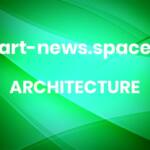40 x 105.6 x 53.9 meters. Photo by Antanas Lukšėnas. Image courtesy of The Lithuanian National Museum of Art, Estate of Aleksandra Kasuba
‘Imagining the Future’ Honors Aleksandra Kasuba’s Trailblazing Installations and Environments
From immersive fabric installations and sculptures to photography, landscape design, and architecture, the work of Aleksandra Kasuba (1923-2019) merges myriad ideas about how we experience the world around us. The intersection of technology and nature enchanted the late Lithuanian artist, and she often experimented with a variety of materials and the effects of light, hue, and tension to explore relationships between ourselves and notions of shelter and place.
The first major exhibition of her work in Europe, Imagining the Future at Carré d’Art—Musée d’Art Contemporain, explores the incredible breadth of Kasuba’s artistry.
Born to an aristocratic family, Kasuba enrolled in art school in 1941, focusing primarily on sculpture and textiles. She married artist Vytautas Kašuba, with whom she fled Lithuania in 1944 in the wake of the Nazi occupation of the country. They landed in a displaced-persons camp in Germany where they stayed until making their way to New York in 1947, and her experience as a refugee and an immigrant significantly affected her work.
In the U.S., Kasuba found employment in crafts and design and began laying the foundations for her future artistic practice, which merged applied and functional arts with abstraction. Her interdisciplinary practice took shape in earnest the 1950s and 1960s and was deeply influenced by tenets of modernism and the era of space exploration, which cast humanity’s existence on Earth in a new light.
Mid-20th century scholarship on vernacular architecture also inspired Kasuba, and she was moved by a visit to Bernard Rudofsky’s 1964 exhibition Architecture Without Architects at the Museum of Modern Art in New York. He took a broader view of global architecture than the field typically covered and emphasized the ingenuity and beauty of structures built by Indigenous cultures.
Rudofsky suggested that modernism—particularly modern architecture—had lost touch with the real needs of society, and he urged viewers to pay attention to artistic, idiosyncratic, culturally rich local styles free from elitist design rules.
Kasuba’s artistic practice blended with daily life in her own living spaces, too, from her New York City home in the 1970s to Rock Hill House, a sculptural dwelling in the New Mexico desert she completed between 2001 and 2005.
The convergence of sculpture and environmental design also fascinated the artist, spurring unique material combinations in large-scale public interventions and spatial installations. Concerned with how we move through places and are affected by our surroundings, she was also commissioned to create numerous public wall installations using materials like brick, marble, and granite.
Kasuba explored the relationships between transparency, color, and light in works like “Spectrum,” privileging organic shapes and an immersive passageway made from stretched nylon. Her Space Shelters series, composed of fabric in curving forms without ninety-degree angles, exemplifies her desire to harmonize nature, people, and technology.
Imagining the Future continues through March 23 in Nîmes, France. Learn more on the museum’s website.


